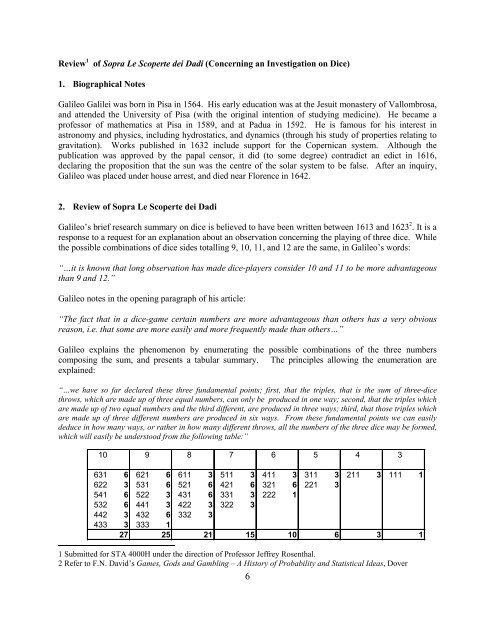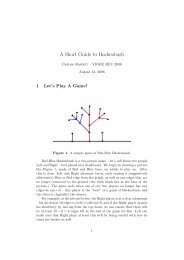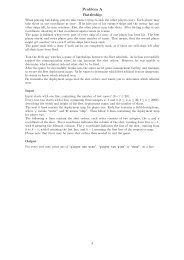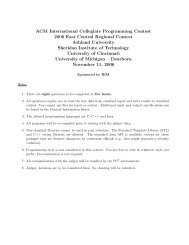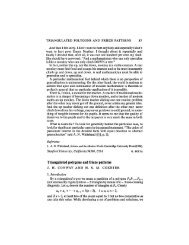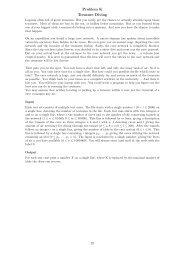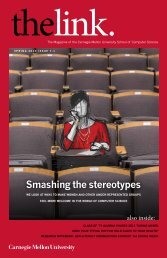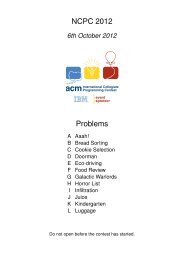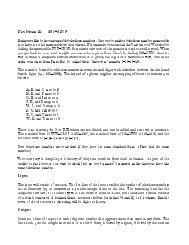Review1 of Liber De Ludo Aleae (Book on Games of Chance) by ...
Review1 of Liber De Ludo Aleae (Book on Games of Chance) by ...
Review1 of Liber De Ludo Aleae (Book on Games of Chance) by ...
You also want an ePaper? Increase the reach of your titles
YUMPU automatically turns print PDFs into web optimized ePapers that Google loves.
Review 1 <str<strong>on</strong>g>of</str<strong>on</strong>g> Sopra Le Scoperte dei Dadi (C<strong>on</strong>cerning an Investigati<strong>on</strong> <strong>on</strong> Dice)<br />
1. Biographical Notes<br />
Galileo Galilei was born in Pisa in 1564. His early educati<strong>on</strong> was at the Jesuit m<strong>on</strong>astery <str<strong>on</strong>g>of</str<strong>on</strong>g> Vallombrosa,<br />
and attended the University <str<strong>on</strong>g>of</str<strong>on</strong>g> Pisa (with the original intenti<strong>on</strong> <str<strong>on</strong>g>of</str<strong>on</strong>g> studying medicine). He became a<br />
pr<str<strong>on</strong>g>of</str<strong>on</strong>g>essor <str<strong>on</strong>g>of</str<strong>on</strong>g> mathematics at Pisa in 1589, and at Padua in 1592. He is famous for his interest in<br />
astr<strong>on</strong>omy and physics, including hydrostatics, and dynamics (through his study <str<strong>on</strong>g>of</str<strong>on</strong>g> properties relating to<br />
gravitati<strong>on</strong>). Works published in 1632 include support for the Copernican system. Although the<br />
publicati<strong>on</strong> was approved <strong>by</strong> the papal censor, it did (to some degree) c<strong>on</strong>tradict an edict in 1616,<br />
declaring the propositi<strong>on</strong> that the sun was the centre <str<strong>on</strong>g>of</str<strong>on</strong>g> the solar system to be false. After an inquiry,<br />
Galileo was placed under house arrest, and died near Florence in 1642.<br />
2. Review <str<strong>on</strong>g>of</str<strong>on</strong>g> Sopra Le Scoperte dei Dadi<br />
Galileo’s brief research summary <strong>on</strong> dice is believed to have been written between 1613 and 1623 2 . It is a<br />
resp<strong>on</strong>se to a request for an explanati<strong>on</strong> about an observati<strong>on</strong> c<strong>on</strong>cerning the playing <str<strong>on</strong>g>of</str<strong>on</strong>g> three dice. While<br />
the possible combinati<strong>on</strong>s <str<strong>on</strong>g>of</str<strong>on</strong>g> dice sides totalling 9, 10, 11, and 12 are the same, in Galileo’s words:<br />
“…it is known that l<strong>on</strong>g observati<strong>on</strong> has made dice-players c<strong>on</strong>sider 10 and 11 to be more advantageous<br />
than 9 and 12.”<br />
Galileo notes in the opening paragraph <str<strong>on</strong>g>of</str<strong>on</strong>g> his article:<br />
“The fact that in a dice-game certain numbers are more advantageous than others has a very obvious<br />
reas<strong>on</strong>, i.e. that some are more easily and more frequently made than others…”<br />
Galileo explains the phenomen<strong>on</strong> <strong>by</strong> enumerating the possible combinati<strong>on</strong>s <str<strong>on</strong>g>of</str<strong>on</strong>g> the three numbers<br />
composing the sum, and presents a tabular summary. The principles allowing the enumerati<strong>on</strong> are<br />
explained:<br />
“…we have so far declared these three fundamental points; first, that the triples, that is the sum <str<strong>on</strong>g>of</str<strong>on</strong>g> three-dice<br />
throws, which are made up <str<strong>on</strong>g>of</str<strong>on</strong>g> three equal numbers, can <strong>on</strong>ly be produced in <strong>on</strong>e way; sec<strong>on</strong>d, that the triples which<br />
are made up <str<strong>on</strong>g>of</str<strong>on</strong>g> two equal numbers and the third different, are produced in three ways; third, that those triples which<br />
are made up <str<strong>on</strong>g>of</str<strong>on</strong>g> three different numbers are produced in six ways. From these fundamental points we can easily<br />
deduce in how many ways, or rather in how many different throws, all the numbers <str<strong>on</strong>g>of</str<strong>on</strong>g> the three dice may be formed,<br />
which will easily be understood from the following table:”<br />
10 9 8 7 6 5 4 3<br />
631 6 621 6 611 3 511 3 411 3 311 3 211 3 111 1<br />
622 3 531 6 521 6 421 6 321 6 221 3<br />
541 6 522 3 431 6 331 3 222 1<br />
532 6 441 3 422 3 322 3<br />
442 3 432 6 332 3<br />
433 3 333 1<br />
27 25 21 15 10 6 3 1<br />
1 Submitted for STA 4000H under the directi<strong>on</strong> <str<strong>on</strong>g>of</str<strong>on</strong>g> Pr<str<strong>on</strong>g>of</str<strong>on</strong>g>essor Jeffrey Rosenthal.<br />
2 Refer to F.N. David’s <strong>Games</strong>, Gods and Gambling – A History <str<strong>on</strong>g>of</str<strong>on</strong>g> Probability and Statistical Ideas, Dover<br />
6


